1998 GMC SIERRA wheel
[x] Cancel search: wheelPage 107 of 452
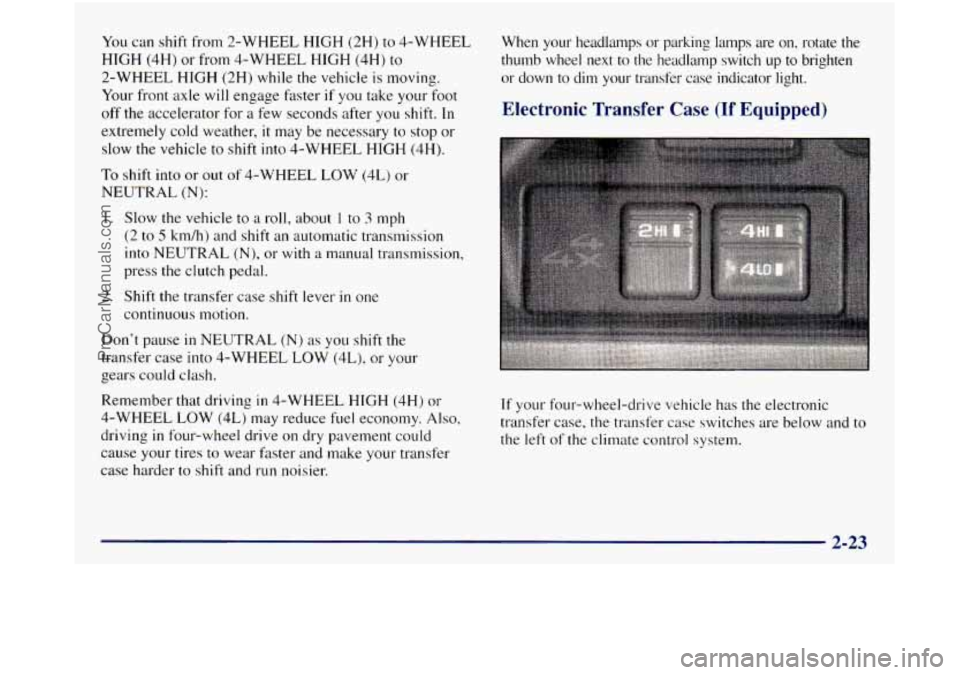
You can shift from 2-WHEEL HIGH (2H) to 4-WHEEL
HIGH (4H) or from 4-WHEEL HIGH (4H) to
2-WHEEL HIGH (2H) while
the vehicle is moving.
Your front axle will engage faster
if you take your foot
off the accelerator for a few seconds after you shift. In
extremely cold weather, it may be necessary to stop or
slow the vehicle
to shift into 4-WHEEL HIGH (4H).
To
shift into or out of 4-WHEEL LOW (4L) or
NEUTRAL
(N):
1. Slow the vehicle to a roll, about 1 to 3 mph
(2
to 5 km/h) and shift an automatic transmission
into NEUTRAL
(N), or with a manual transmission,
press the clutch pedal.
2. Shift
the transfer case shift lever in one
continuous motion.
Don’t pause
in NEUTRAL (N) as you shift the
transfer case into 4-WHEEL LOW (4L), or your
gears
could clash.
Remember that driving
in 4-WHEEL HIGH (4H) or
4-WHEEL LOW (4L) may reduce
fuel economy. Also,
driving
in four-wheel drive on dry pavement could
cause your tires to wear faster and make your transfer
case harder
to shift and run noisier. When your headlamps
or parking lamps are on, rotate the
thumb wheel next
to the headlamp switch up to brighten
or down to dim your transfer case indicator light.
Electronic Transfer Case (If Equipped)
If your four-wheel-drive vehicle has the electronic
transfer case,
the transfer case switches are below and to
the left of the climate control system.
2-23
ProCarManuals.com
Page 108 of 452
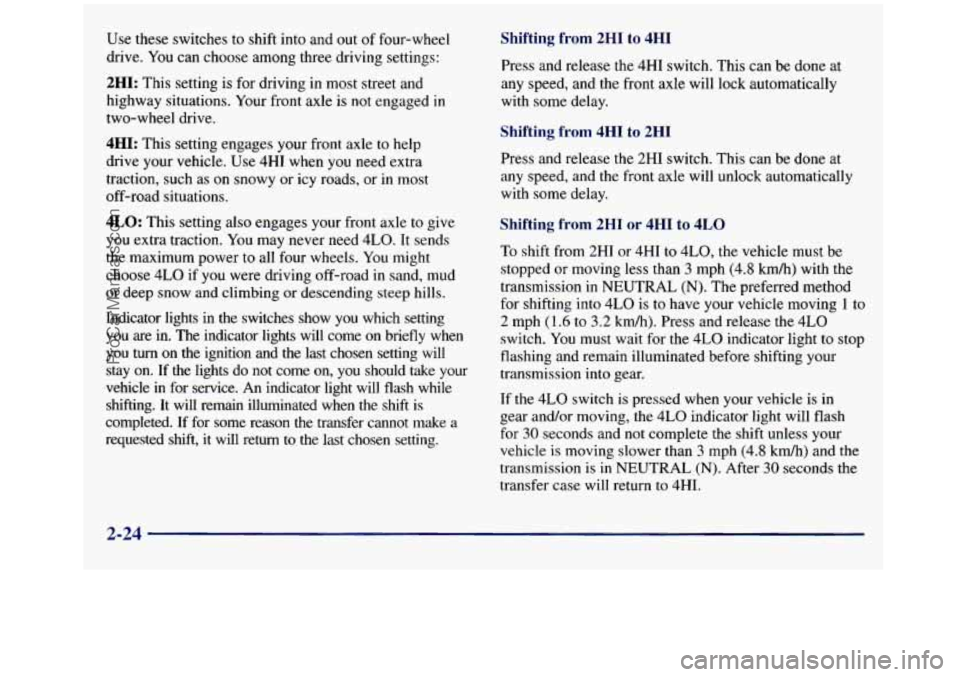
Use these switches to shift into and out of four-wheel
drive. You can choose among three driving settings:
2HI: This setting is for driving in most street and
highway situations. Your front axle is not engaged
in
two-wheel drive.
4HI: This setting engages your front axle to help
drive your vehicle. Use 4HI when you need extra
traction, such as
on snowy or icy roads, or in most
off-road situations.
4LO: This setting also engages your front axle to give
you extra traction. You may never need 4LO. It sends
the maximum power to all
four wheels. You might
choose 4LO if you were driving off-road in sand, mud
or deep snow and climbing or descending steep hills.
Indicator lights in the switches show you which setting
you are in. The indicator lights will come on briefly when
you
turn on the ignition and the last chosen setting will
stay on. If the lights
do not come on, you should take your
vehicle in for service. An indicator light will flash while
shifting. It will remain illuminated when
the shift is
completed. If for some reason the transfer cannot make a
requested shift, it will return
to the last chosen setting.
Shifting from 2HI to 4HI
Press and release the 4HI switch. This can be done at
any speed, and the front axle will lock automatically
with some delay.
Shifting from 4HI to 2HI
Press and release the 2HI switch. This can be done at
any speed, and the front axle will unlock automatically
with some delay.
ting from 2HI or 4HI to 4LO
'li hift from 2HI or 4HI to 4L0, the vehicle must be
stopped or moving less than
3 mph (4.8 km/h) with the
transmission in
NEUTRAL (N). The preferred method
for shifting into 4LO is to have your vehicle moving
1 to
2 mph (1.6 to
3.2 kmh). Press and release the 4LO
switch. You must wait for the
4LO indicator light to stop
flashing and remain illuminated before shifting your
transmission into gear.
If the 4LO switch is pressed when your vehicle is in
gear and/or moving, the 4LO indicator light will flash
for 30 seconds and not complete the shift unless your
vehicle is moving slower than
3 mph (4.8 kmh) and the
transmission is
in NEUTRAL (N). After 30 seconds the
transfer case will return to 4HI.
2-24
ProCarManuals.com
Page 110 of 452
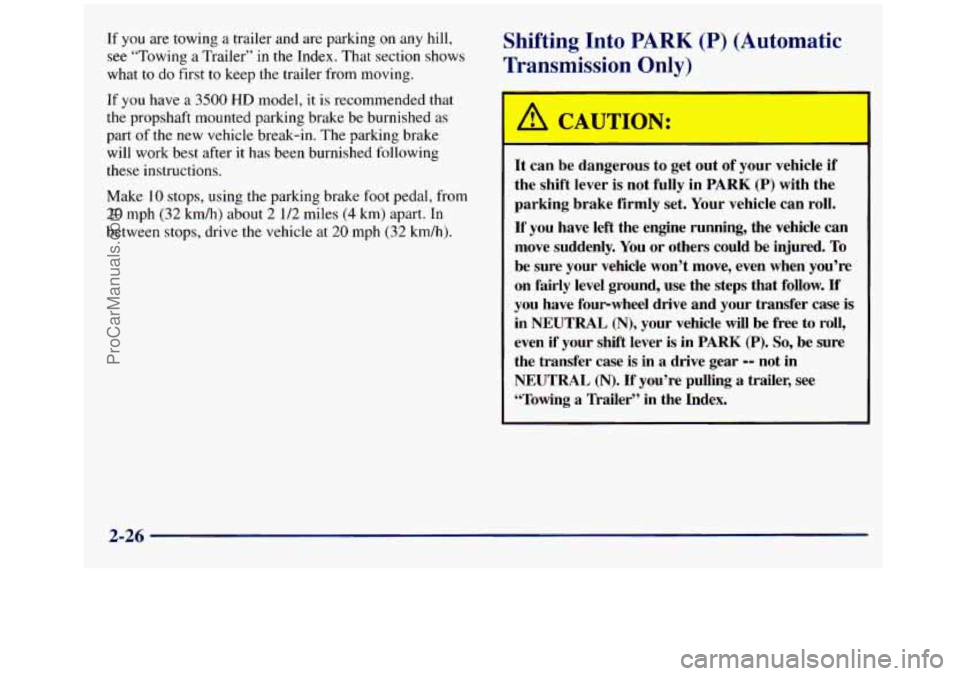
If you are towing a trailer and are parking on any hill,
see “Towing a Trailer” in the Index. That section shows
what to do first
to keep the trailer from moving.
Shifting Into PARK (P) (Automatic
Transmission Only)
If you have a 3500 HD model, it is recommended that
the propshaft mounted parking brake be burnished
as
part of the new vehicle break-in. The parking brake
will work best after
it has been burnished following
these instructions.
Make
10 stops, using the parking brake foot pedal, from
20 mph (32 kmh) about 2 1/2 miles (4 km) apart. In
between stops, drive the vehicle at
20 mph (32 km/h).
A CAUTION:
-
It can be dangerous to get out of your vehicle if
the shift lever is not fully in PARK (P) with the
parking brake firmly
set. Your vehicle can roll.
If you have left the engine running, the vehicle can
move suddenly. You
or others could be injured. To
be sure your vehicle won’t move, even when you’re
on fairly level ground, use the steps that follow.
If
you have fourwheel drive and your transfer case is
in
NEUTRAL (N), your vehicle will be free to roll,
even
if your shift lever is in PARK (P). So, be sure
the transfer case is in a drive gear
-- not in
NEUTRAL (N). If you’re pulling a trailer, see
“Towing a Trailer” in the Index.
2-26
ProCarManuals.com
Page 111 of 452
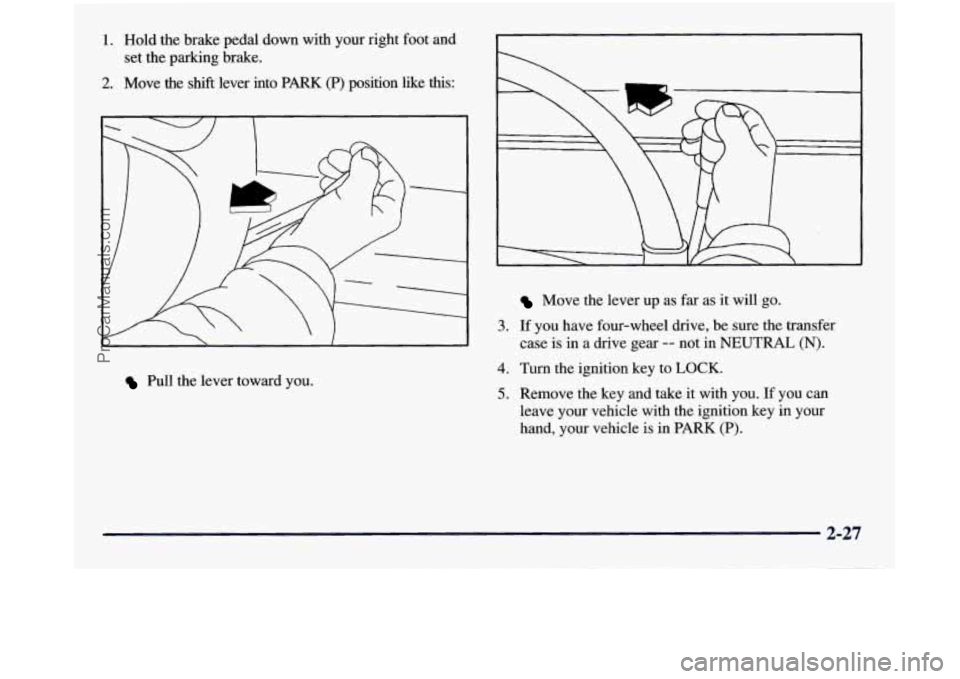
1.
2.
Hold the brake pedal down with your right foot and
set the parking brake.
Move
the shift lever into PARK (P) position like this:
r
3.
Pull the lever toward you.
4.
5.
Move the lever up as far as it will go.
If you have four-wheel drive, be sure the transfer
case is in a drive gear
-- not in NEUTRAL (N).
Turn the ignition key to LOCK.
Remove the key and take it with you. If you can
leave your vehicle with the ignition key in your
hand, your vehicle is in PARK
(P).
2-27
ProCarManuals.com
Page 112 of 452
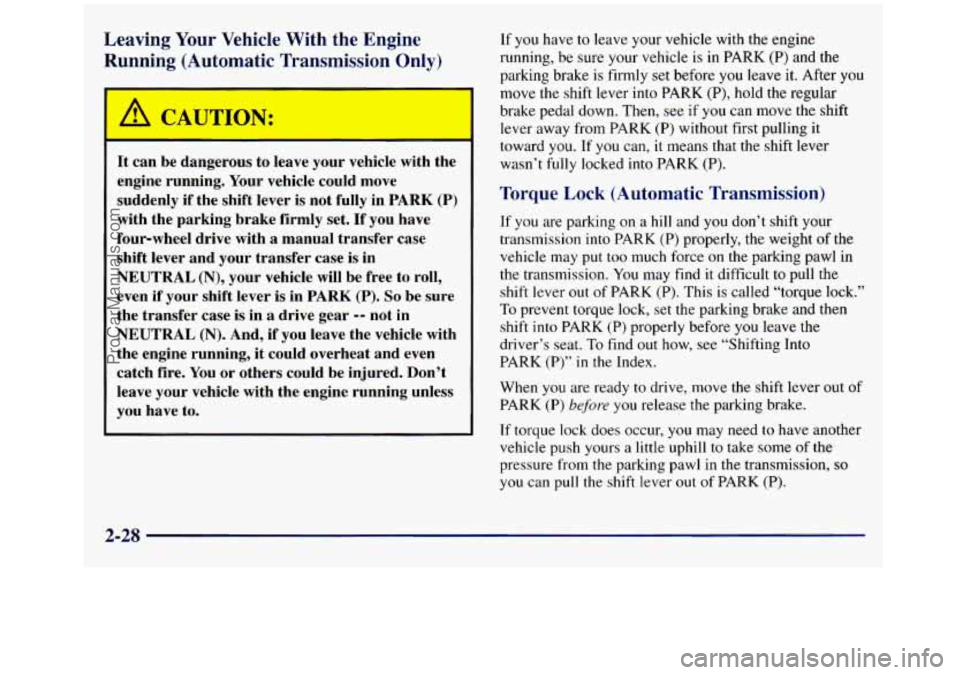
Leaving Your Vehicle With the Engine
Running (Automatic Transmission
Only)
I A CATJTION:
It can be dangerous to leave your vehicle with the
engine running. Your vehicle could move
suddenly if the shift lever
is not fully in PARK (P)
with the parking brake firmly set. If you have
four-wheel drive with
a manual transfer case
shift lever and your transfer case is in
NEUTRAL
(N), your vehicle will be free to roll,
even if your shift lever is in PARK
(P). So be sure
the transfer case is in
a drive gear -- not in
NEUTRAL
(N). And, if you leave the vehicle with
the engine running, it could overheat and even
catch fire.
You or others could be injured. Don’t
leave your vehicle with the engine running unless
you have to. If you
have to leave your vehicle with the engine
running, be sure your vehicle
is in PARK (P) and the
parking brake is firmly set before you leave it. After
you
move the shift lever into PARK (P), hold the regular
brake pedal down. Then, see if you can move the shift
lever away from PARK
(P) without first pulling it
toward you. If you can, it means that
the shift lever
wasn’t
fully locked into PARK (P).
Torque Lock (Automatic Transmission)
If you are parking on a hill and you don’t shift your
transmission into PARK (P) properly, the weight of the
vehicle may put
too much force on the parking pawl in
the transmission.
You may find it difficult to pull the
shift lever out of PARK
(P). This is called “torque lock.”
To prevent torque lock, set the parking brake and then
shift
into PARK (P) properly before you leave the
driver’s seat.
To find out how, see “Shifting Into
PARK
(P)” in the Index.
When
you are ready to drive, move the shift lever out of
PARK (P)
before you release the parking brake.
If torque lock does occur, you may need to have another
vehicle push yours a little uphill to take some
of the
pressure from the parking pawl in the transmission,
so
you can pull the shift lever out of PARK (P).
2-28
ProCarManuals.com
Page 113 of 452
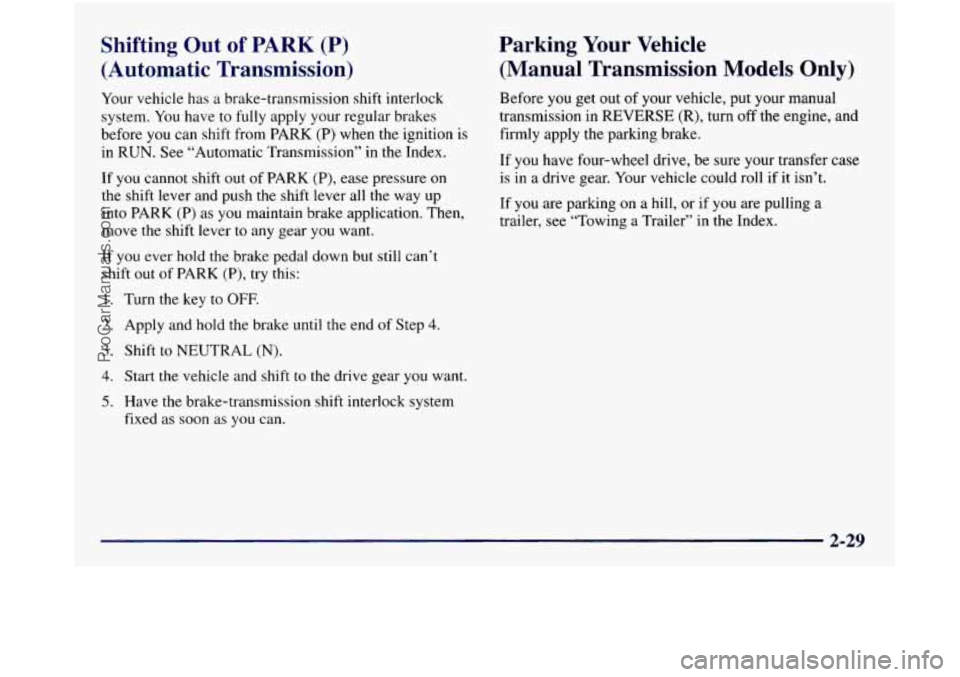
Shifting Out of PARK (P)
(Automatic Transmission)
Your vehicle has a brake-transmission shift interlock
system. You have to fully apply your regular brakes
before you can shift from PARK
(P) when the ignition is
in
RUN. See “Automatic Transmission” in the Index.
If you cannot shift out of PARK
(P), ease pressure on
the shift lever and push the shift lever all the way up
into PARK
(P) as you maintain brake application. Then,
move the shift lever
to any gear you want.
If you ever hold the brake pedal down but still can’t
shift
out of PARK (P), try this:
1. Turn the key to OFF.
2. Apply and hold the brake until the end of Step 4.
3. Shift to NEUTRAL (N).
4. Start the vehicle and shift to the drive gear you want.
5. Have the brake-transmission shift interlock system
fixed as
soon as you can.
Parking Your Vehicle
(Manual Transmission Models
Only)
Before you get out of your vehicle, put your manual
transmission in REVERSE
(R), turn off the engine, and
firmly apply the parking brake.
If you have four-wheel drive, be sure your transfer case
is in a drive gear. Your vehicle could roll if it isn’t.
If
you are parking on a hill, or if you are pulling a
trailer, see “Towing a Trailer” in
the Index.
2-29
ProCarManuals.com
Page 115 of 452
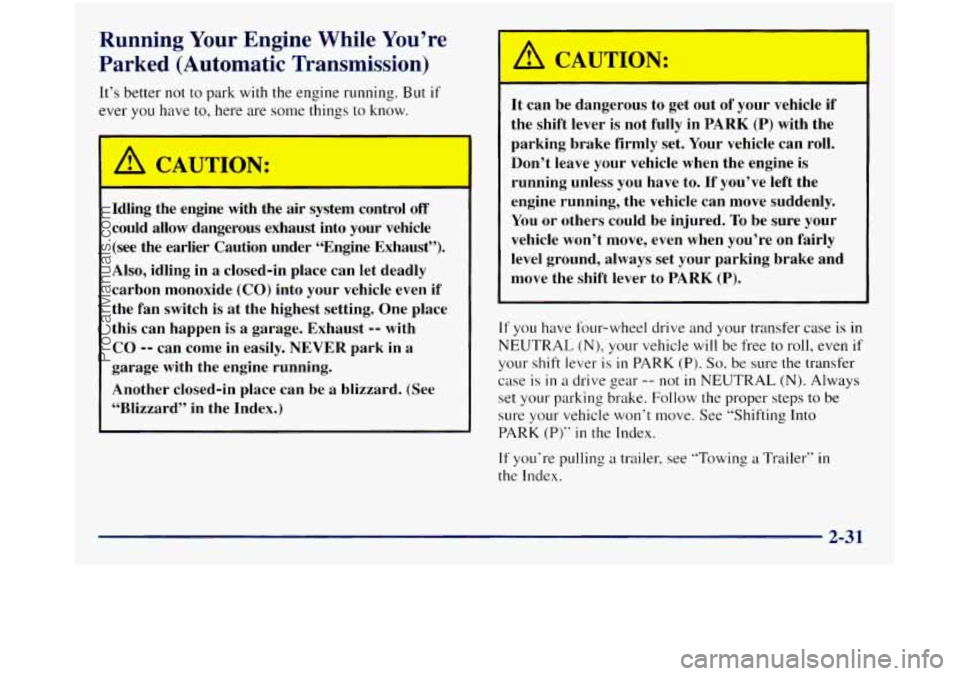
Running Your Engine While You’re
Parked (Automatic
1 ~ ission) an
It’s better not to park with the engme rblllling. But if
ever you have to, here are some things to know.
c
A A AUTION: -1
i Idling the engine with the air system control off
could allow dangerous exhaust into your vehicle
(see the earlier Caution under “Engine Exhaust”).
Also, idling in a closed-in place can let deadly
carbon monoxide
(CO) into your vehicle even if
the fan switch is at the highest setting. One place
this can happen is a garage. Exhaust
-- with
CO -- can come in easily. NEVER park in a
garage with the engine running.
Another closed-in place can be a blizzard. (See
“Blizzard” in the Index.)
4 CAUT- IN: -
It can be dangerous to get out of your vehicle if
the shift lever is not fully in
PARK (P) with the
parking brake firmly set. Your vehicle can
roll.
Don’t leave your vehicle when the engine is
running unless you have to. If you’ve left the
engine running, the vehicle can move suddenly.
You or others could be injured.
To be sure your
vehicle won’t move, even when you’re on fairly
level ground, always set your parking brake and
move the shift lever to
PARK (P).
If you have four-wheel drive and your transfer case is in
NEUTRAL (N), your vehicle will be free to roll, even if
your shift lever is in PARK (P). So. be sure the transfer
case is in a drive gear -- not in NEUTRAL (N). Always
set your parking brake. Follow the proper steps to be
sure your vehicle won’t move.
See ”Shifting Into
PARK
(P)” in the Index.
If you’re pulling a trailer. see “Towing a Trailer” in
the Index.
2-31
ProCarManuals.com
Page 116 of 452
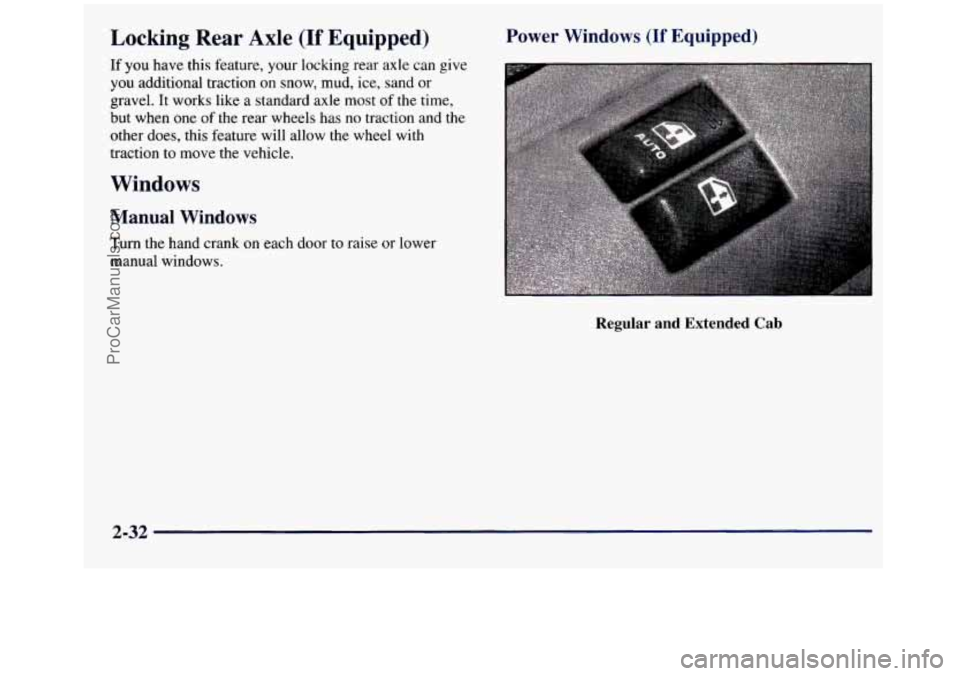
Locking Rear Axle (If Equipped)
If you have this feature, your locking rear axle can give
you additional traction on snow, mud, ice, sand or
gravel. It works like a standard axle most of the time,
but when one
of the rear wheels has no traction and the
other does, this feature will allow
the wheel with
traction to move the vehicle.
Windows
Manual Windows Power Windows
(If Equipped)
Turn the
hand crank on each door to raise or lower
manual windows.
Regular and Extended Cab
2-32
ProCarManuals.com